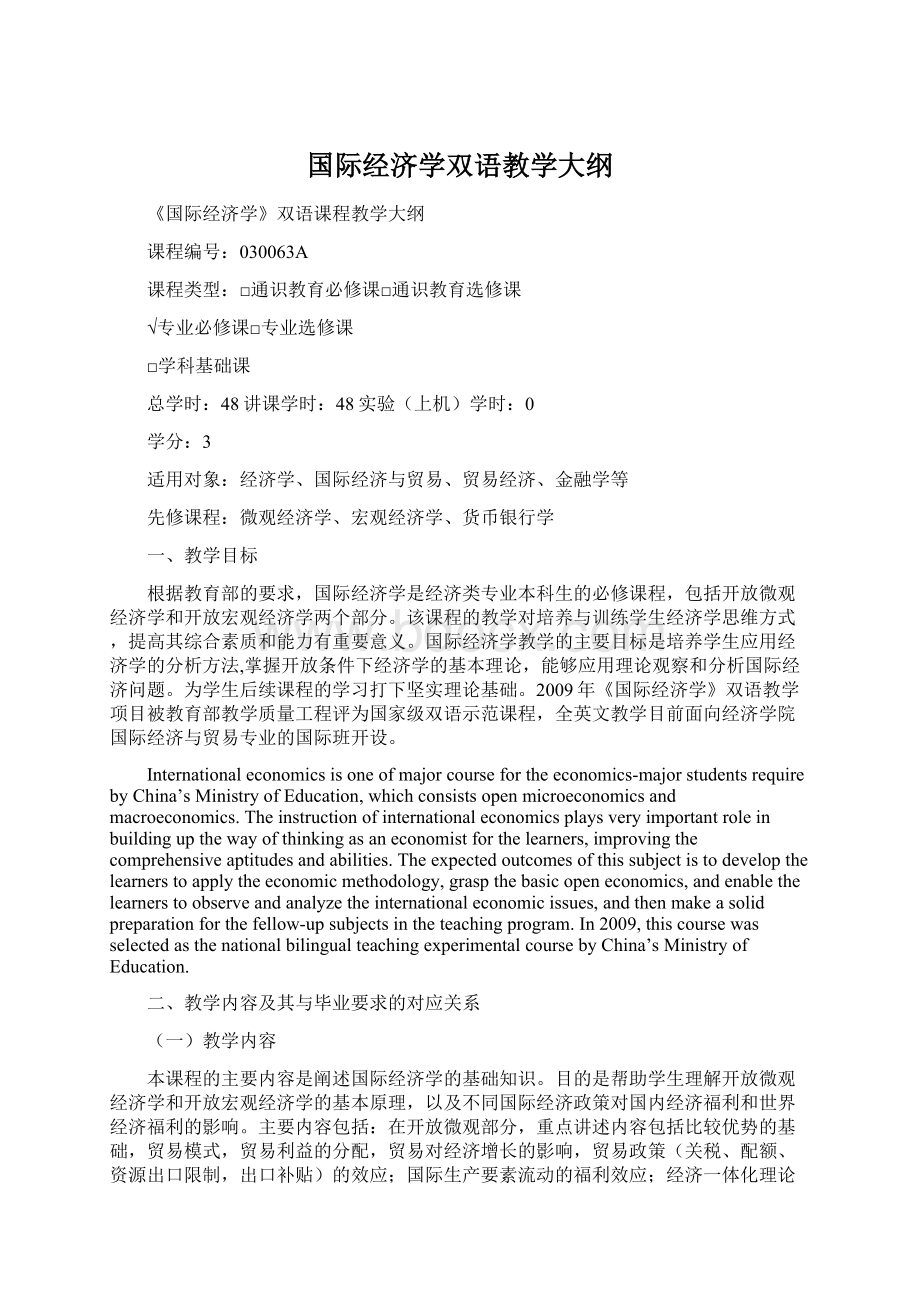国际经济学双语教学大纲.docx
《国际经济学双语教学大纲.docx》由会员分享,可在线阅读,更多相关《国际经济学双语教学大纲.docx(21页珍藏版)》请在冰豆网上搜索。

国际经济学双语教学大纲
《国际经济学》双语课程教学大纲
课程编号:
030063A
课程类型:
□通识教育必修课□通识教育选修课
√专业必修课□专业选修课
□学科基础课
总学时:
48讲课学时:
48实验(上机)学时:
0
学分:
3
适用对象:
经济学、国际经济与贸易、贸易经济、金融学等
先修课程:
微观经济学、宏观经济学、货币银行学
一、教学目标
根据教育部的要求,国际经济学是经济类专业本科生的必修课程,包括开放微观经济学和开放宏观经济学两个部分。
该课程的教学对培养与训练学生经济学思维方式,提高其综合素质和能力有重要意义。
国际经济学教学的主要目标是培养学生应用经济学的分析方法,掌握开放条件下经济学的基本理论,能够应用理论观察和分析国际经济问题。
为学生后续课程的学习打下坚实理论基础。
2009年《国际经济学》双语教学项目被教育部教学质量工程评为国家级双语示范课程,全英文教学目前面向经济学院国际经济与贸易专业的国际班开设。
Internationaleconomicsisoneofmajorcoursefortheeconomics-majorstudentsrequirebyChina’sMinistryofEducation,whichconsistsopenmicroeconomicsandmacroeconomics.Theinstructionofinternationaleconomicsplaysveryimportantroleinbuildingupthewayofthinkingasaneconomistforthelearners,improvingthecomprehensiveaptitudesandabilities.Theexpectedoutcomesofthissubjectistodevelopthelearnerstoapplytheeconomicmethodology,graspthebasicopeneconomics,andenablethelearnerstoobserveandanalyzetheinternationaleconomicissues,andthenmakeasolidpreparationforthefellow-upsubjectsintheteachingprogram.In2009,thiscoursewasselectedasthenationalbilingualteachingexperimentalcoursebyChina’sMinistryofEducation.
二、教学内容及其与毕业要求的对应关系
(一)教学内容
本课程的主要内容是阐述国际经济学的基础知识。
目的是帮助学生理解开放微观经济学和开放宏观经济学的基本原理,以及不同国际经济政策对国内经济福利和世界经济福利的影响。
主要内容包括:
在开放微观部分,重点讲述内容包括比较优势的基础,贸易模式,贸易利益的分配,贸易对经济增长的影响,贸易政策(关税、配额、资源出口限制,出口补贴)的效应;国际生产要素流动的福利效应;经济一体化理论,经济一体化组织的效应,主要阐述关税同盟的效应。
在开放宏观经济学部分,将探讨国际收支、汇率决定、开放宏观经济政策及国际货币体系。
ThisisanintroductorycoursetoInternationalEconomics.Thepurposeofthiscourseistohelpstudentsunderstandthebasicsofopenmicroeconomicsandopenmacroeconomicsfinance,andtheeffectsofvariousinternationaleconomicpoliciesondomesticandworldwelfare.
Inmicroeconomicspart,thecoursewillhighlightsourcesofcomparativeadvantage,patternsoftrade,gainsandlossesfromtrade,andeffectsoftradepolicyinterventionssuchastariffs,quotas,voluntaryexportrestraints,andexportsubsidies;thewelfareeffectsofinternationalfactormobility;Internationaleconomicintegrationtheory,theformsofinternationaleconomicorganizationanditseffects,theeffectsofcustomunionwillbefocused.
Inopenmacroeconomicspart,itwillincludebalanceofpayments,determinationofforeignexchangerates,openmacroeconomicpolicyandinternationalmonetarysystem.
(二)教学方法和手段
由于教学内容理论性较强,主要以理论教授为主。
同时安排“读、写、议”课堂以便学生能够深入理解基本原理;指定学生进行国际经济时闻阅读和重要文章阅读,指导学生撰写小论文;组织学生分组进行主题课堂讨论。
Thecourseisverytheoretical,anditwillkeepanon-technicalprofile,thuswewillnotgooverthemathematicalmodelingtechniquesbutwewillconcentrateongraph.Theinformationflowwillconcentrateonthelecture,andwewillarrange“reading,writinganddiscussion”classtohelplearnerstounderstandthebasicprincipledeeply;requirethestudentstoreadandreleasethenewsofinternationalissues,importantreviews;Directthestudentstowriteessays;organizein-classgrouppresentationbasedontopics.
学习网站:
(CourseWebpage)
(三)学习要求
先修课程:
微观经济学、宏观经济学、货币银行学
PreparatoryCourses:
Microeconomics,Macroeconomics,Money&Banking
课后作业:
Homeworkfromproblemsontextbook
学生自学:
Readingmaincontentsbeforetheclassmeeting,andreadingnewsfrommedias;teamworkonsometopics.
综上本课程的教学内容,使学生能够灵活运用所学的经济学基础知识理解并分析国际经济活动中的现象,促进了其毕业要求的实现。
三、各教学环节学时分配
教学课时分配
序号
章节内容
讲课
实验
其他
合计
1
第一章绪论
第二章Chapter1Introduction
1
阅读时闻
Reading
课后习题
exercises
1
2
第二章比较优势原理
Chapter2TheLawOfComparativeAdvantage
4
课后习题
exercises
4
3
第三章国际贸易的标准理论
Chapter3TheStandardTheoryOfInternationalTrade
4
课后习题
exercises
4
4
第四章需求与供给、提供曲线与贸易条件
Chapter4:
DemandAndSupply,OfferCurvesAndTheTermsOfTrade
3
课后习题
exercises
3
5
第五章要素禀赋理论:
赫克歇尔-俄林模型与里昂剔夫之谜
Chapter5FactorEndowmentsandtheHeckscher-OhlinTheory,LeontiefParadox
3
课后习题
exercises
3
6
第六章新贸易理论:
规模经济、重叠需求、不完全竞争与国际贸易
Chapter6EconomiesOfScale,ImperfectCompetition,Overlapping
Demand,AndInternational
4
课后习题
exercises
4
7
第七章关税
Chapter7TheTariff
4
阅读时闻
Reading
课后习题与讨论
Exercises,discussion
4
8
第八章非关税壁垒与新贸易保护主义
Chapter8Non-TariffBarriersAndNewTradeProtectionism
4
阅读时闻
Reading
课后习题
exercises
4
9
第九章经济一体化:
关税同盟的效应:
贸易创造与贸易转移
Chapter9EconomicIntegration:
TheEffectsOfCustomUnion
3
GroupDiscussion:
3
10
第十章国际生产要素流动:
资本、劳动
Chapter10InternationalResourceMovements:
Capital,Labor
2
课后习题
exercises
2
11
第十一章国际收支与国际收支调节理论
Chapter11BalanceOfPaymentsandAdjustmentOfBOPDisequilibrium
5
课后习题
exercises
5
12
第十二章外汇市场、汇率与汇率决定
Chapter12FXMarketAndExchangeRateDetermination
4
阅读时闻
Reading
课后习题exercises
4
13
第十三章固定汇率下宏观经济内外均衡
Chapter13MacroeconomicEquilibriumUnderFixedExchangeRateRegime
2
课后习题
exercises
2
14
第十五章浮动汇率下宏观经济内外均衡
Chapter15MacroeconomicEquilibrium
2
课后习题
exercises
2
15
第十六章国际货币体系